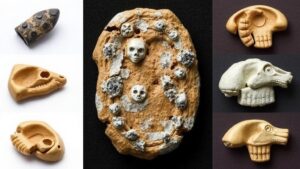Amber Fossil Rainforests: Exploring Ancient Tropical Ecosystems Trapped in Resin
Amber Fossil Rainforests: Exploring Ancient Tropical Ecosystems Trapped in Resin
Amber, a fossilized tree resin, has captivated collectors and scientists alike due to its incredible ability to preserve ancient life forms. Not merely beautiful, amber serves as a time capsule of prehistoric ecosystems, with some deposits containing remnants of entire tropical rainforests. This article delves into the fascinating world of amber fossil rainforests, their formation, significance, and how rockhounds and mineral collectors can appreciate and acquire these unique specimens.
The Formation of Amber and Its Significance
Amber originates from tree resin that has been polymerized over millions of years. process begins when resin oozes from trees in response to injury or environmental stress. Once this resin hardens and is buried beneath layers of sediment, the conditions facilitate geological processes that transform it into amber. The most significant deposits of amber are found in regions such as the Baltic States, the Dominican Republic, and Myanmar.
Significantly, amber is often laden with inclusions–organisms that were trapped within the resin before it solidified. This includes:
- Insects, such as mosquitoes and beetles
- Plant material, including leaves and flowers
- Other small organisms like arachnids and amphibians
These inclusions provide a snapshot of biodiversity from the Cretaceous and Eocene epochs, offering insights into the ecosystems of ancient tropical rainforests, which once flourished in these regions. For example, amber from the Dominican Republic has been dated to around 20-30 million years old, making it a significant source for studying the life forms of the time.
The study of inclusions in amber has enhanced our understanding of ancient ecosystems. Research has identified more than 1.5 million ancient species embedded in amber, but estimates suggest that only a fraction of total inclusions have been discovered. A remarkable example includes the finding of a 100 million-year-old Burmese amber piece containing a feather of a bird-like dinosaur, providing critical evidence of evolution during the Mesozoic era.
Statistical studies have shown that the biodiversity preserved in amber ecosystems is indicative of their original environments. In a study of Baltic amber, researchers found that around 80% of the inclusions were insects, which elucidates the prevalence of insects in ancient tropical rainforests.
Pursuing Amber: Tips for Rockhounds and Collectors
For rockhounds and mineral collectors, acquiring amber with inclusions can be both exciting and rewarding. Here are some practical tips for sourcing and identifying quality amber fossil specimens:
- Research Sources: Understand where authentic amber comes from. Baltic region and the Dominican Republic are reputable locations known for their quality amber.
- Look for Inclusions: The more diverse and comprehensive the inclusions, the more valuable the amber. Seek out pieces with clear, well-preserved inclusions.
- Check Authenticity: Always verify the authenticity of amber. Natural amber typically has a warm feel and is lightweight. Conduct tests like the saltwater test to differentiate between real amber and plastic replicas.
Real-World Applications of Amber Studies
The implications of amber studies extend beyond mere curiosity; they serve critical roles in various scientific fields. For example:
- Climate Research: Analyzing amber inclusions helps scientists understand past climates and ecosystems, which is essential for predicting future environmental changes.
- Evolutionary Biology: Amber finds can lead to revelations about evolution and the interrelations of species.
Conclusion: Embracing the Past through Amber
Amber fossil rainforests are not just remnants of the past; they present a unique opportunity to connect with ancient ecosystems. For collectors, the allure of amber lies not only in its beauty but also in the silent stories that lie trapped within. As you pursue amber specimens, remember that each piece carries with it a fragment of history, representing the rich biodiversity of ancient tropical rainforests.
By following the tips outlined and staying informed about scientific discoveries surrounding amber, rockhounds and collectors can deepen their appreciation for this ancient material while contributing to the ongoing exploration of our planets biological history.



